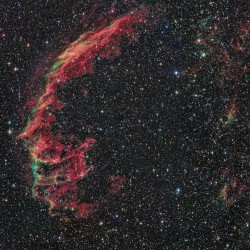
The Vela Nebula Complex by Johannes Schedler
Floating like a vast, thin wreath on a sea filled with colorful, bright stars, these wisps and tendrils are all that’s left to mark the ancient resting place of an exploded sun. The star detonated in a flash of light that would have rivaled the full moon in the sky. The accompanying thumbnail image is just a small part of a much larger collection of structures that, combined, form a unique northern night sky object known as the Veil Nebula Complex.
Located in the constellation of Cygnus, the Veil Nebula Complex floats approximately 1,400 light years from our home planet; the remains of a supernova event that took place in pre-history, between 5,000 and 10,000 years ago. It’s estimated that the light from this explosion was visible in the night sky for several months and easily cast shadows on the ground for over a week after it initially detonated. Over time, the energy and material that was ejected into the inter-stellar medium has now expanded until it covers an area over six times the diameter of the full moon.
This spectacular image is particularly unique in that the colors displayed are not natural- they have been scientifically enhanced through the use of filters and special image processing. For example, the red coloration indicates areas of the nebula where hydrogen gas is plentiful and has been excited into radiating a crimson color. The blue and green areas represent places where enormous amounts of molecular oxygen are the primary nebula constituent. This picture is a good example of the way science uses light and hue to understand the makeup of the cosmos through the use of special filters that only transmit the glow of specific elements. By assigning unique colors to each element, a map of its component distribution can be created, thus this process is also known as mapped coloring.
Johannes Schedler produce this picture, actually a mosaic of six separate images seamlessly stitched together, from his backyard observatory located in Wildon, a small town near the city of Graz, in south-eastern Austria. The pictures were taken through a 16-inch (410mm) telescope operating at f/3. For each of the six images used in this huge sky panorama, Johannes gathered the ancient light for over three and a half hours with a CCD camera. In total, the entire mosaic represents a twenty-two hour exposure!
Do you have photos you’d like to share? Post them to the Universe Today astrophotography forum or email them, and we might feature one in Universe Today.
Written by R. Jay GaBany
